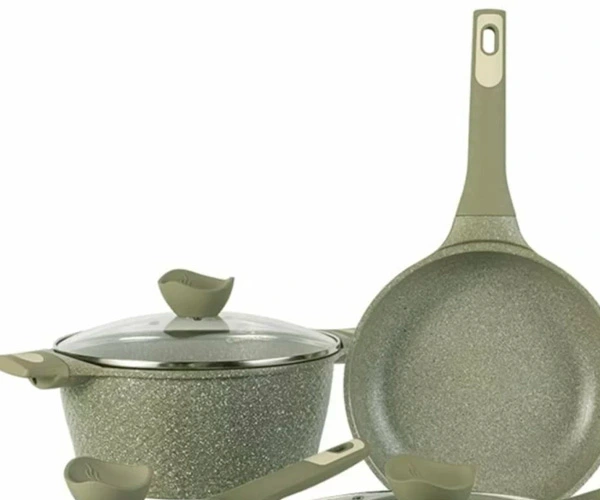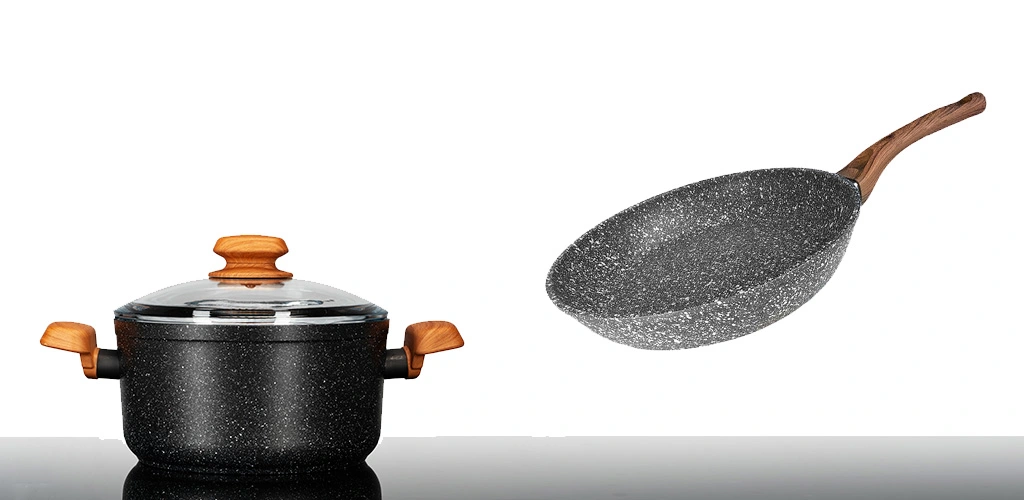When it comes to cookware there are two popular options – ceramic and nonstick. Both have advantages over stainless steel and cast iron. Their downsides must be considered.
A ceramic non-stick glaze is coated with natural clay and minerals. A smooth, inert frying surface prevents food from sticking. Teflon, or polytetrafluoroethylene (PTFE), coats nonstick cookware, making it slippery.
This article compares pros and cons of ceramic and nonstick cookware. Cooking performance, durability, safety, usability, and affordability are important. This might help you choose the finest alternative for your cooking needs and preferences. Each sort of cookware is briefly described below for context.
Table of Contents
Pros and Cons of Ceramic and Nonstick Cookware
Pros of Ceramic Cookware
Since it’s nonstick and easy to clean, ceramic cookware has grown in popularity. Ceramic cookware has several benefits:
- Nonstick Properties: Ceramic coating makes cooking surfaces incredibly smooth, preventing food from sticking. Ceramic pans are sometimes claimed to be more nonstick than Teflon. The nonstick characteristics simplify cooking and cleaning.
- The ultra-smooth ceramic surface makes cleaning easy. Ceramic cookware rarely retains food. Cleaning ceramic pans using a sponge or soft cloth typically works. It doesn’t need aggressive scouring like stainless steel or other cookware.

Cons of Ceramic Cookware
There are drawbacks to ceramic cookware:
- Compared to aluminum and nonstick cookware, ceramic pots and pans are heavier. Dense ceramic adds weight. This makes ceramic cookware harder to lift, clean, and move.
- Ceramic coating chips and scratches more easily than other nonstick surfaces. Knocked or dropped ceramic cookware chips due to its brittleness Chips and scratches reveal the pan’s base metal, allowing food to stick.
Pros of Nonstick Cookware
Lightweight
Lightweight, nonstick cookware is a benefit. Lighter aluminum or aluminum alloys are used to make nonstick cookware than cast iron or steel. Nonstick pans are lighter and easier to lift for cooking and moving food. It also helps people who struggle to move heavier cookware. Heat is also less energy-intensive with lightweight materials.
Not expensive
Compared to ceramic or stainless steel, nonstick cookware is more affordable. Simple metal nonstick pans are inexpensive. Even high-quality nonstick brands are affordable for most home cooks. The nonstick coating is very cheap. This makes nonstick cookware easy to replace if the coating wears off. The low cost makes a whole set of nonstick cookware affordable.
Cons of Nonstick Cookware
Nonstick cookware has several drawbacks to consider before buying.
Scratching-prone
Metal utensils and abrasive scouring can scratch and chip nonstick cookware, which is a major downside. Food sticks more when the nonstick surface is degraded. You must be careful with nonstick cookware and avoid metal equipment that could damage the coating.

Potential Health Hazards
Nonstick coatings may pose health and safety risks. Perfluorooctanoic acid (PFOA) may cause thyroid illness and cancer. Most current nonstick pans employ PFOA-free compositions. However, nonstick coatings can disintegrate and generate harmful fumes at high temperatures. Only overheating above 500°F is a risk.
Even though most new nonstick pans are safe, use them at low to medium heat to avoid chemical odors. Cooking with nonstick cookware requires proper ventilation.
Safety and Health
Cookware safety and health are major priorities for most home cooks. Ceramic and nonstick options should be assessed for overheating and toxicity.
Risks of Overheating
Extremely hot ceramic and nonstick pots and pans can be dangerous. Nonstick has additional risks in this regard. Overheated empty nonstick coating can break down and generate harmful fumes at about 500°F. These vapors are harmful.
If accidentally overheated, ceramic cookware is safer. Quality ceramic coating can endure high temperatures. You should avoid extreme temperature increases with any cookware. Preheating slowly on medium heat is best.
Potential toxicity
Nonstick surfaces may leach chemicals into food, especially with older or damaged coatings. Modern quality nonsticks employ safer formulas. At high heat, minute amounts of perfluorinated compounds may migrate.
100% of ceramic coatings are non-toxic and chemical-free. Ceramic doesn’t leach into food under normal cooking circumstances because it’s inert and stable. Health safety benefits from ceramic
Ceramic and nonstick cookware need proper upkeep. Ceramic outperforms nonstick because it releases fewer fumes or poisons when hot. Health-conscious people will appreciate ceramic’s non-reactive function.
Cost Comparison
Cookware prices vary by material and brand. Ceramic and nonstick prices and lifespans vary.
Start-up Cost
Ceramic cookware normally costs more than nonstick. Quality ceramic pots and pans cost $100–300, while cheap nonstick sets cost $30-100. Ceramics from luxury companies can cost over $300. Ceramic costs extra due to its stronger materials and workmanship.
Nonstick is commonly accessible at reduced prices because the coating is cheaper. This makes nonstick cheap, but it reduces durability.
The lifespan
Carefully maintained ceramic cookware should endure for years. Ceramic scratches and degrades less than nonstick. High-quality earthenware can last decades. This makes the upfront cost worthwhile over time.
Regular use wears out nonstick coatings after 3–5 years. Scratches diminish the nonstick effect. This requires new nonstick pans every few years, which is costly. Some pricier nonstick brands stay longer, but the coatings deteriorate.
Although ceramic costs more, it should last longer. Nonstick is cheap but needs refilling every few years. Buying quality ceramic cookware over time is cheaper than nonstick.
Cleanup and Maintenance
Cleaning ceramic cookware by hand takes more effort. The porous ceramic surface requires moderate cleaning to remove food particles and stains. Although porcelain is naturally nonstick, foods stick less stubbornly than in stainless steel pans. Carefully maintained ceramic cookware lasts for years. The glazed surface might chip or shatter from severe handling.
Nonstick cookware is the simplest to clean. Pans clean easily with hot water and a gentle sponge or cloth; food residue washes off. However, constant use wears off the nonstick coating within a few years. The pan becomes tougher to clean. High heat and metal utensils destroy some nonstick coatings. Nonstick cookware may need replacing every 2–5 years for simple cleaning.
Cooking Quality
Choosing ceramic vs. nonstick cookware depends heavily on cooking performance. This involves heat distribution, browning, and usability.
Slow yet consistent heating is typical for ceramic cookware. Ceramic is less conductive than metal, so it takes longer to heat up. The heating surface is usually even once hot. Food cooks evenly without hot spots or scorching with this even heating. Through even contact, ceramic’s smooth surface may brown meals well. Some ceramic pans may not heat enough to sear.
Nonstick pans heat quickly but less evenly than ceramic. Heat flows well through the metal base. However, nonstick coating transfer heat less efficiently. This can produce hot areas and inconsistent warmth. Nonstick surfaces might also struggle to sear or brown. The nonstick layer prevents browning from the Maillard process. While safer at lower temperatures, nonstick pans may need more oil for searing.
For uniform heating and browning, ceramic is ideal for low to medium heat cooking. However, nonstick may be superior for rapid boiling or high-temperature searing.
For uniform heating and browning, ceramic is ideal for low to medium heat cooking. However, nonstick may be superior for rapid boiling or high-temperature searing. Consider your typical cooking style when deciding between the two.
If we need to select ceramic vs. nonstick cookware for microwave oven use, ceramic is the best option. However, it’s important to ensure that the specific ceramic cookware you have is labeled as microwave-safe.
Cost Comparison Table: Ceramic vs. Nonstick
| Start-up Cost | Ceramic cookware: $100–300 (quality) / >$300 (luxury) | Nonstick cookware: $30–100 (cheap) | |
| Lifespan | Despite higher initial cost, ceramic may be more cost-effective over time | Regular replacement of nonstick pans is costly | |
| Cleanup and Maintenance | Ceramic requires more effort to clean | Porous ceramic surface needs moderate cleaning | Nonstick is easy to clean initially | Nonstick coating deteriorates over time | |
| Cooking Quality | Ceramic: Slow, consistent heating; even surface | Ideal for low to medium heat cooking | Nonstick: Quick heating, less even | May require more oil for searing |
Conclusion and Recommendations
Both ceramic and nonstick cookware have merits and cons.
Although safer and more environmentally friendly, ceramic cookware can chip and lose nonstick characteristics. Heat is evenly distributed for cooking. Ceramic is suitable for bakeware and low-to-medium cooking.
Nonstick cookware is convenient and easy to clean. It degrades over time and releases hazardous fumes if overheated. Nonstick works excellent for eggs, pancakes, and other delicate dishes that stick.
Both ceramic and nonstick offer benefits in different situations. For safety and environmental reasons, ceramic pans may be better, although nonstick performs better for delicate cooking. Consider your cooking style and demands. Properly maintained pans of either type can last. Using quality cookware and following manufacturer directions will be ideal.
Considering the pros and cons of ceramic and nonstick cookware, our recommendation leans towards ceramic cookware. Although ceramic can chip, its safety, even heat distribution, and versatility make it a good choice for cooking. Nonstick cookware is convenient but degrades and carries health hazards. Safety-conscious cooks should use ceramic cookware, which is safer and greener. The choice relies on your cooking style and preferences. Regardless of material, appropriate care and manufacturer guidelines will extend the life of cookware.
